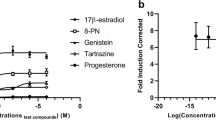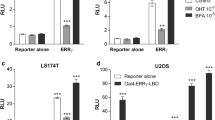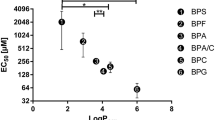Summary
Increasing concerns over the effects of environmental estrogens on wildlife and humans have highlighted the need for screening systems to assess potentially estrogenic effects of test compounds. As a result, in vitro screening methods such as cell proliferation assays using the estrogen-responsive human breast cancer cell line, MCF-7, have been developed. The present study describes an alternative in vitro approach for the assessment of such xenoestrogens, based on estrogenic rescue of MCF-7 cells from antiestrogen-induced cytotoxicity. This method measures the ability of various estrogenic compounds to compete with a known estrogen-receptor-mediated antihormonal drug, 4-hydroxytamoxifen, using the 1-[4,5-dimethylthiazol-2-yl]-3,5-diphenylformazan (MTT) assay to assess mitochondrial activity. Because 4-hydroxytamoxifen treatment of cells results in a dramatic decrease in mitochondrial dehydrogenase activity which is directly related to their estrogen-receptor content, inhibition of this effect with estrogenic compounds represents an estrogen-receptor interaction, or estrogenic rescue. The estrogenic compounds tested include a weak xenoestrogen, bisphernol A (BPA), and two biological estrogens, 17α- and 17β-estradiol. Competitive inhibition of 4-hydroxytamoxifen-induced cytotoxicity by BPA was compared to that of the biological estrogens. The results indicate that the biological estrogens can successfully compete with the antiestrogen in a dose-dependent manner. In addition, the assay is sensitive enough to detect estrogenic rescue by even the very weak xenoestrogen, BPA, albeit at high BPA concentrations. This simple in vitro method could be used as an alternative or second-line screen for potential xenoestrogens.
Similar content being viewed by others
References
Berthois, Y.; Katzenellenbogen, J. A.; Katzenellenbogen, B. S. Phenol red in tissue culture media is a weak estrogen: implications concerning the study of estrogen-responsive cells in culture. Proc. Natl. Acad. Sci. U S A 83:2496–2500; 1986.
Brontons, J. A.; Olea-Serrano, M. F.; Villalobos, M.; Pedraza, V.; Olea, N. Xenoestrogens released from lacquer coatings in food cans. Environ. Health Perspect. 103:608–612; 1995.
Colburn, T. Environmental estrogens: health implications for humans and wildlife. Environ. Health Perspect. 103 (Suppl. 7):135–136; 1995.
Darbre, P.; Yates, J.; Curtis, S.; King, R. J. Effect of estradiol on human breast cancer cells in culture. Cancer Res. 43:349–354; 1983.
Dodds, E. C.; Lawson, W. Synthetic estrogenic agents without the phenanthrene nucleus. Nature 137:996; 1936.
Feldman, D.; Krishnan, A. Estrogens in unexpected places: possible implications for researchers and consumers. Environ. Health Perspect. 103:129–133; 1995.
Ferracane, J. L.; Condon, J. R. Rate of elution of leachable components from composite. Dent. Mater. 6:282–287; 1990.
Hamid, A.; Hume, W. R. A study of component release from resin pit and fissure sealants in vitro. Dent. Mater. 13:98–102; 1997.
Hendry, L. B.; Rueggeberg, F. A.; Davis, R. E. Endocrine activity of bisphenol-A evaluated by computer modeling. J. Dent. Res. 76:236; 1997
Korach, K. S. Surprising places of estrogenic activity. Endocrinology 132: 2277–2278; 1993.
Krishnan, A. V.; Stathis, P.; Permuth, S. F.; Tokes, L.; Feldman, D. Bisphenol-A: an estrogenic substance is released from polycarbonate flasks during autoclaving. Endocrinology 132:2279–2286; 1993.
Kuiper, G. G. J. M.; Lemmen, J. G.; Carlsson, B.; Corton, J. C.; Safe, S. H.: van der Saag, P. T.; van der Burg, B.; Gustafsson, J.-A. Interaction of estrogenic chemicals and phytoestrogens with estrogen receptor β. Endocrinology 139:4252–4263; 1998.
Kyprianou, N.; English, H. F.; Davidson, N. E.; Isaacs, J. T. Programmed cell death during regression of the MCF-7 human breast cancer following estrogen ablation. Cancer Res. 51:162–166; 1991.
Lewis, J. B.; Rueggenberg, F. A.; Lapp, C. A., et al. Identification and characterization of estrogen-like components in commercial resin-based dental restorative materials. Clin. Oral Invest. 3:107–113; 1999.
Nathanson, D.; Lerpitayakun, P.; Lamkin, M. S.; Edalatpour, M.; Chou, L. L. In vitro elution of leachable components from dental sealants. JADA 128:1517–1523, 1997.
Olea, N.; Pulgar, R.; Pérez, P. et al. Estrogenicity of resin-based composites and sealants used in dentistry. Envitron. Health Perspect. 104:298–305; 1996.
Peterson, G.; Barnes, S. Génistein inhibition of the growth of human breast cancer cells: independence from estrogen receptors and the multidrug resistance gene. Biochem. Biophys. Res. Commun. 179:661–667; 1991.
Safe, S. Is there an association between exposure to environmental estrogens and breast cancer? Environ. Health Perspect. 105:675–678; 1997.
Schafer, T. E.; Lapp, C. A.; Hanes, C. M.; Lewis, J. B.; Wataha, J. C.; Schuster, G. S. Estrogenicity of bisphenol A and bisphenol A dimethacrylate in vitro. J. Biomed. Mater. Res. 45:192–197; 1999.
Skehan, P.; Storeng, R.; Scudiero, D., et al. New colorimetric cytotoxicity assay for anti-cancer-drug screening. J. Natl. Cancer Inst. 82:1108–1112; 1990.
Soto, A. M.; Lin, T. M.; Justicia, H.; Silvia, R. M.; Sonnenschein, C. An “in culture” bioassay to assess the estrogenicity of xenobiotics (ESCREEN). In: Colburn, T.; Clement, C., ed. Chemically induced alterations in sexual and functional development; the wildlife/human connection. Princeton, NJ: Princeton Scientific Publishing; 1992:295–309.
Soule, H. D.; Vaszuea, J.; Long, A.; Albert, S.; Brennan, M. J., A human cell line from a pleural effusion derived from a breast carcinoma. J. Natl. Cancer Inst. 51:1409–1416; 1973.
Stone, R. Environmental estrogens stir debate. Science 265:308–310; 1994.
Villalobos, M.; Olea, N.; Brotons, J. A.; Olea-Serrano, M. F.; Ruiz de Almodovar, J. M.; Pedraza, V. The E-screen assay: a comparison of different MCF7 stocks. Environ. Health Perspect. 103:844–850; 1995.
Wang, T. T. Y.; Phang, J. M. Effects of estrogen on apoptotic pathways in human breast cancer cell line MCF-7. Cancer Res. 55:2487–2489; 1995.
Wang, T. T. Y.; Sathyamoorthy, N.; Phang, J. M. Molecular effects of genistein on estrogen receptor mediated pathways. Carcinogenesis 17:271–275; 1996.
Wataha, J. C.; Craig, R. G.; Hanks, C. T. Precision of and new methods for testing in vitro alloy cytotoxicity. Dent. Mater. 8:65–71; 1992.
Welsh, J. Induction of apoptosis in breast cancer cells in response to vitamin D and antiestrogens. Biochem. Cell Biol. 72:537–545; 1994.
Author information
Authors and Affiliations
Corresponding author
Rights and permissions
About this article
Cite this article
Lewis, J.B., Lapp, C.A., Schafer, T.E. et al. 4-Hydroxytamoxifen-induced cytotoxicity and bisphenol a: Competition for estrogen receptors in human breast cancer cell lines. In Vitro Cell.Dev.Biol.-Animal 36, 320–326 (2000). https://doi.org/10.1290/1071-2690(2000)036<0320:HICABA>2.0.CO;2
Received:
Accepted:
Issue Date:
DOI: https://doi.org/10.1290/1071-2690(2000)036<0320:HICABA>2.0.CO;2




